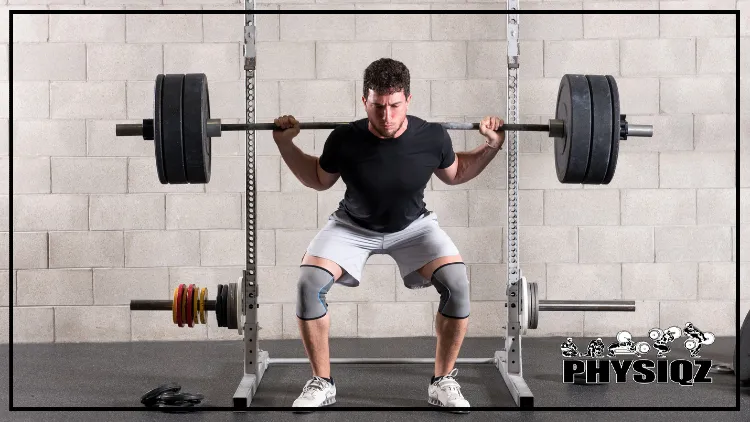
Back squat workouts are one of the best ways to build muscle and/or lose weight since they can truly shape your physique into a dream body.1
In addition, squat workout plans, whether a barbell routine or CrossFit workout of the day, offers an array of functional and hormonals benefits that no other exercise comes close to.
So before delving into a squat-based barbell workout routine and CrossFit work out of the day routines, let’s review how to perform squats properly, the best way to warm up, and cover what makes for a great program focused on back squats as well as why squats are so beneficial.
How To Perform a Squat Safely & With Perfect Form
When it comes to exercise, form is everything because weight lifters must be sure that they are utilizing the proper form during their workouts to avoid risk of injury.
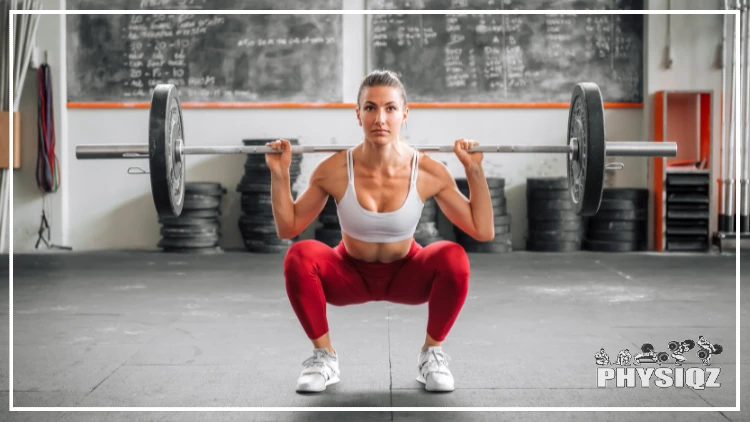
Source: photology2000 via Canva.com2
In order to fully understand the breakdown of proper squatting ergonomics, it’s recommended for readers to view The Squat University form breakdown. They break down squatting form into the following five categories: toe angle, foot stability, external rotation torque, hinging at the hips, and postural stability. Let’s take a look at each category.
Toe Angle – Start with the knees roughly shoulder length apart with the toes slightly pointed outwards or abducted. This is the starting position that sets up the rest of the squat, and aids in the maintenance of alignment during the exercise.
Foot Stability – To maximize balance, make sure to spread the toes as far away from each other as possible. This increases the base of support and makes the entire squat much more stable.
External Rotation Torque – In order to maximize movement, knees should be facing slightly outwards. This creates an increased stability and allows for the hips to move along a vertical plane while maintaining power.
Hinging Hips – The hips have to hinge for a squat to take place. After the first three categories are completed, the hips move back in a hinging motion and the chest moves forward. This allows for the actual squat to take place.
Postural Stability – Postural stability is key to a good squat. To maintain this aspect of a squat, keep the back in neutral alignment. Too much flexion or hyperextension of the back can result in a loss of proper squatting form.
Check out the linked video for a visual demonstration and a further breakdown of these categories to maximize squat form. While watching the video, keep in mind the genetics that are affecting your squat form.
Completing a few sample reps with no weight can help a lifter understand how the movement should feel. It’s also recommended that if a lifter is unfamiliar with a certain exercise or is inexperienced at lifting, then they should research the exercise form beforehand.
There are online guides that detail ways to perform the perfect squat, as well as useful online demonstrations to aid in the ergonomics behind lifting.3 Weight lifters using a barbell should keep in mind the bench press technique and the squat bar path to maximize their efficiency.
If form is starting to be sacrificed, then it might be best to use a lower weight and a high amount of reps. Using too high of weight can lead to injury and might even cause long term damage. Surgery cost is very expensive, so it’s better to be safe than sorry.
Squatting Warm Up Protocol
Warming up is vital for maintaining health, regardless of if a Crossfit WOD or barbell routine is being used. It is well researched that a proper warm up prior to weight lifting or cardio is key in injury prevention. With this in mind, it is best practice for weight lifters to engage in a brief five to fifteen minute warm up prior to every workout.
The best warm up should consist of movement and stretching. Weight lifters should try jumping rope, an easy jog, or even low impact fast paced walking to assist with increasing blood flow, overall body heat, and tissue elasticity.
Furthermore, stretching the muscles involved in an exercise will improve movement and active range of motion while aiding in the prevention of muscle strain or tendon and ligament sprain. Lifters engaging in squat exercises and barbell squats should target their hamstrings, glute muscles, and quadriceps during their stretching period.
Furthermore, weight lifters should work their way up towards their goal weight prior to their actual lifting set. Kettlebell swings or the use of dumbbells can be a great tool for warming up, as weights can vary to meet a lifter’s needs and provides a small but progressive overload on the muscles to aid in the warming up process.
Additionally, utilizing these methods as warm ups can put less strain on the back, which is a key for lifters with previous back injuries or issues with compression on the spine.
Squat University is a highly recommended resource for heavy weight lifters interested in learning how to squat their best. Check out the video below for a great back squat routine warm up that both prevents injury from occurring and maximizes squat performance.
Keep in mind that research suggests that a proper warm up not only prevents serious and long term injury. Properly warming up the muscles prior to lifting and cardio will also significantly improve overall physical performance.4
Weight lifters who are struggling to reach their goals may find that warming up is the missing piece to their workout.
The Ultimate Barbell Squat Routine (Top Squat Workout Program)
In order to build the best barbell squat routine, a lifter has to determine the frequency in which they can target their squatting muscle group. While the frequency of weight lifting can change based on an individual lifter’s needs, this generalized routine is based on doing barbell squats twice a week.
Remember to space workouts for the same muscle groups a few days apart to allow for recovery.
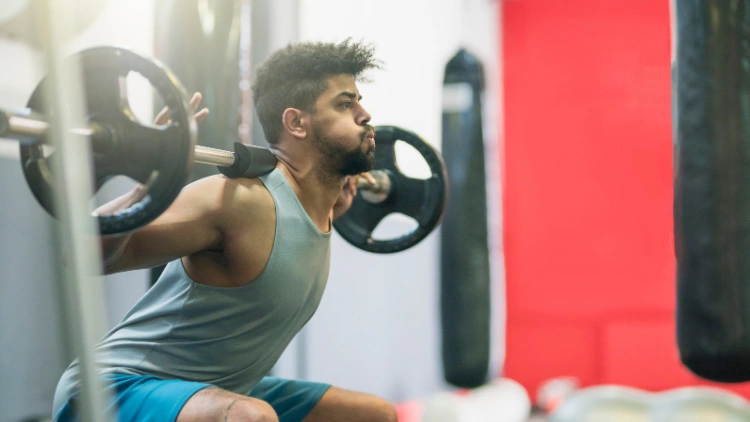
Source: SrdjanPav via Canva.com5
Research suggests that in order to maximize muscle hypertrophy, or more simply put, the growth of muscle cells, weight lifters should aim anywhere between 12 and 20 sets per week.6
So if an individual is to squat or back squat twice during the week, then their individual workout is recommended to have between 6 and 10 sets of squatting. Weight lifters who want to use a deadlift workout should know that they can even squat and deadlift same day to reach the optimal amount of sets per muscle group a week.
Weight lifters should keep in mind that the barbell’s placement on the back can impact the muscles involved and overall dynamics of a squat itself. Weight lifters are encouraged to understand high bar vs low bar squat placement, and the effect it has on a workout.
In order to best determine if a workout is working, weight lifters should be feeling fatigue by their last set and sore during their recovery period. If soreness is low, then weight lifters would benefit from adding more volume to their workouts. This can be done through increasing the number of sets, the number of reps, or the amount of weight used per exercise.
Make sure to track progress by writing down the stats. Weight will vary depending on an individual’s strength capacity.
Warm up with a brisk walk or light jog for five to ten minutes. Complete additional first sets with low weight and high reps to prevent injury. Research suggests that active stretching techniques are best for sustained flexibility.7
On squat days, stretching should target hips and thigh muscles, especially the hamstrings and glutes.
Note, the following will be in a sets x reps format. So for example 3×10 means 3 sets, for 10 reps.
Week 1:
- Day 1 (Quads)
- Barbell Front Squats: 3×3
- Hack Squats: 2×3
- Seated Leg Curls: 3×3
- Leg Press Calf Raises: 3×3
- Day 2 (Rest)
- Day 3 (Glute and Hamstrings)
- Reps Barbell Back Squats: 3×3
- Reps Leg Press: 3×3
- Reps Deadlifts: 3×3
- Reps Seated Leg Extension: 3×3
- Reps Leg Press Calf Raises: 3×3
- Day 4 (Rest)
- Day 5 (Generalized Lower Body)
- Reps Barbell Back Squat: 3×3
- Reps Deadlifts: 3×3
- Reps Hack Squats: 3×3
- Reps Leg Press Calf Raises: 3×3
- Day 6 (Rest)
- Day 7 (Rest)
Week 2:
- Day 1 (Quads)
- Reps Front Bar Squat: 4×3
- Reps Hack Squat: 4×3
- Reps Seated Leg Curl: 4×3
- Reps Calves on Leg Press: 4×3
- Day 2 (Rest)
- Day 3 (Glute and Hamstrings)
- Reps Back Barbell Squat: 4×3
- Reps Leg Press: 4×3
- Reps Deadlift: 4×3
- Reps Seated Leg Extension: 4×3
- Reps Calves on Leg Press: 4×3
- Day 4 (Rest)
- Day 5 (Generalized Lower Body)
- Reps Back Barbell Squat: 4×3
- Reps Deadlift: 4×3
- Reps Hack Squat: 4×3
- Reps Calves on Leg Press: 4×3
- Day 6 (Rest)
- Day 7 (Rest)
Week 3:
- Day 1 (Quads)
- Reps Front Bar Squat: 5×2
- Reps Hack Squat: 5×2
- Reps Seated Leg Curl: 5×2
- Reps Calves on Leg Press: 5×2
- Day 2 (Rest)
- Day 3 (Glute and Hamstrings)
- Reps Back Barbell Squat: 5×2
- Reps Leg Press: 5×2
- Reps Deadlift: 5×2
- Reps Seated Leg Extension: 5×2
- Reps Calves on Leg Press: 5×2
- Day 5 (Generalized Lower Body)
- Reps Back Barbell Squat: 5×2
- Reps Deadlift: 5×2
- Reps Hack Squat: 5×2
- Reps Calves on Leg Press: 5×2
- Day 6 (Rest)
- Day 7 (Rest)
Week 4:
- Day 1 (Quads)
- Reps Front Bar Squat: 6×2
- Reps Hack Squat: 6×2
- Reps Seated Leg Curl: 6×2
- Reps Calves on Leg Press: 6×2
- Day 2 (Rest)
- Day 3 (Glute and Hamstrings)
- Reps Back Barbell Squat: 6×2
- Reps Leg Press: 6×2
- Reps Deadlift: 6×2
- Reps Seated Leg Extension: 6×2
- Reps Calves on Leg Press: 6×2
- Day 4 (Rest)
- Day 5 (Generalized Lower Body)
- Reps Back Barbell Squat: 6×2
- Reps Deadlift: 6×2
- Reps Hack Squat: 6×2
- Reps Calves on Leg Press: 6×2
- Day 6 (Rest)
- Day 7 (Rest)
Week 5:Deload by repeating Week 1’s regime.
Other Back Squat Workout Routines Proven to Build Muscle
There are countless back squat workout routines to choose from, especially if muscle growth is the overall goal. Readers are encouraged to try any of the programs noted below to help them achieve their fitness goals.
#1. Body Recomposition Squat Program
Body recompositioning has been studied to decrease body fat percentage while increasing muscle.8 To do this, exercises require X12 reps minimum with progressive overloading from week to week. In order to properly recomposition the body, a lifter should aim for adequate protein and be eating enough calories for maintenance.
Lifters who are serious about building muscle and burning fat should utilize protein shakes diet plans to make sure their protein needs are being met.
Leg Day 1
4 Sets X 12 Reps of the following:
- Barbell Back Squats
- Glute Kickbacks
- Single Leg Press
- Weighted Reverse Lunge
Leg Day 2
3 Sets X 8 Reps of the following:
- Hack Squat
- Hip Thrusts
- Leg Curls
- Leg Extensions
#2. Standard Squat Routine
This routine is ideal for those wanting to harden muscles. This regime is broken into two leg days over a 6 week period. Weight should be progressively added on each week. Exercises should be difficult to complete by the last rep.
Leg Day 1
3 Sets X 8 Reps of the following:
- Barbell Back Squats
- Barbell Front Squats
- Seated Leg Curl
- Calf Raises until failure.
Leg Day 2
3 Sets X 8 Reps of the following:
- Barbell Single Leg Squat
- Barbell Front Squats
- Seated Leg Extension
- Hip Abduction
#3. Endurance Challenge
This is the perfect squatting routine for individuals who are wanting to obtain cardio, core work, and muscle building in a single workout. This workout calls for 12 minute circuits completed as fast as possible, with 15 reps per exercise. Circuits can be mixed and matched, and 2-3 circuits should be completed per session.
Circuit 1
- Jump Squats
- Bicycle Crunches
- Goblet Squats
- Reverse Bicycle Crunches
Circuit 2
- Low Weight Barbell Back Squat
- 1 minute plank
- Burpees
- Walking Lunges
Circuit 3
- X Jumps
- Leg Climbs
- Bulgarian Split Squat
- Box Jumps
Circuit 4
- Weighted Step Ups
- Mountain Climbers
- Barbell Front Squat
- Wide Leg Sit Ups
Crossfit Squat Training & WODs
Crossfit is unique from the exercise programs listed above. Crossfit utilizes functional movements in their exercises with high amounts of intensity in order to help maximize fitness and strength training. Furthermore, Crossfit offers a workout of the day method to not only motivate weight lifters but also improve muscle growth and health for Crossfitters across the globe. It’s even backed by research to improve long and short term endurance and muscle strength.9
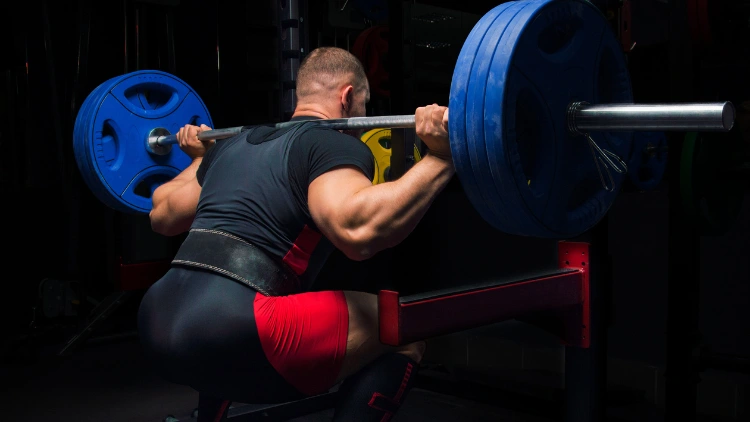
Source: Andy__Gin via Canva.com10
There are a number of beneficial squat workouts in CrossFit that are recommended to weightlifters regardless of experience. Due to the many Crossfit WODs out there, there is no single Crossfit squat or back squat routine that is the best.
All of them are useful, especially if gaining muscle is the goal. In order to benefit the most from Crossfit’s WOD or workout of the day, lifters are encouraged to make a personalized squat list to help create the best workout routine possible.
Making a personalized squat workout of the day can be easy! Simply search for squat routines on the Crossfit website, and make note of what workouts fall into varying categories. A Crossfitter can then mix and match their workouts of the day depending on what type of squat or muscle group they want to target.
Check out the examples below of Crossfit workouts of the day for quad dominant and hamstring/glute dominant exercises.
And of course, remember to add more weight, reps, or sets each week to progressively overload.
Back Squat Workout of the Day
Back squat Crossfit workouts of the day or WODs involve movements that are glute and hamstring dominant. Typically, this is a squat completed with the barbell or weight resting behind the neck on the weight lifter’s back.
Exercises involving back squats include barbell back squats and barbell single leg squats. Check out the routine below to target back squats over an eight week period:
Leg Day 1
4 Sets X 12 Reps of the following:
- Barbell Back Squats
- Reverse Lunge
- Leg Curls
- 100 Jump Roped
Leg Day 2
3 Sets X 8 Reps of the following:
- Squat Clean
- Glute Kick Back
- Leg Press
- Calf Raises
Front Squat Workout of the Day
Front squat workouts of the day from Crossfit are going to be quad dominant and involve squatting with the weight placed in front of the body. Crossfit workouts of the day that utilize front squats will be routines that involve barbell front squats, squat cleans, muscle cleans, and power cleans.
Check out the routine below to target front squats over an eight week period:
Leg Day 1
4 Sets X 8 Reps of the following:
- Front Squat with Barbell
- Walking Lunge
- Leg Extension
- Calf Raises
Leg Day 2
4 Sets X 8 Reps of the following:
- Hack Squat
- Goblet Squat
- Hip Abduction
- Calf Raises
What Makes an Effective Squat Workout Program or Routine?
Many weight lifters, especially beginners looking to add on leg definition, might wonder what makes an effective squat workout routine or program. Well, there are actually a few things that play a role.
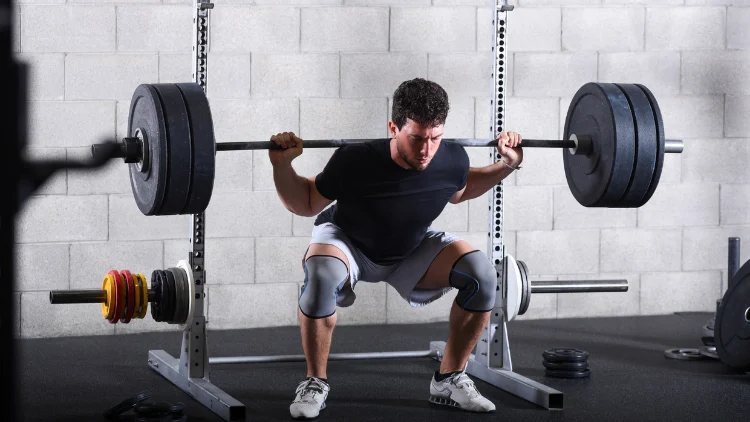
Source: photology2000 via Canva.com11
First and foremost, using a program that facilitates enough weight, reps, and sets is key for an effective squat workout and overall routine. If muscle hypertrophy is the goal, then lifters should be feeling tired by the last few reps of an exercise.
Research suggests that weight lifters should be increasing either their load or reps in order to see maximum strength improvements.12 This technique is called progressive overloading, and is key for building muscle and strength.
Along with progressive overload, a good squat routine is only good if it is used consistently. Remember the saying Rome wasn’t built in a day. Well, neither is a muscled body. In order to see results, lifters must consistently hit the gym and workout their key muscle groups.
Perhaps the most important key to a good back squat training routine or program is feeling good. A workout should be hard on the body and leave a person tired afterwards.
But it should also leave a person feeling satisfied and proud of themselves. If a workout isn’t causing endorphins, or happy hormones, to flood the brain afterwards, then it might be time to switch up the routine for something different.
Frequency
When it comes to how often a lifter should squat, the answer can vary depending on the amount of weight and reps a person uses as well as their overall fitness goals. With that being said, there is various research on the subject in order to help maximize muscle growth and overall health outcomes.
One study suggests that it is better to train the major muscle groups involved in squatting at least twice a week in comparison to only one time per week.13 This assisted lifters in seeing maximal muscle gains.
It’s important to keep in mind that individual routines need to be further researched in order to determine the best frequency for muscle growth and strength improvement.
The frequency in which a person goes to the gym is not the only factor that matters when determining how often to squat and back squat. Weight lifters should also be mindful of the amount of sets completed per muscle group per week.
Remember, research suggests that in order to maximize muscle growth or muscle hypertrophy, lifters should be doing anywhere between 12 and 20 sets per week. Weight lifters are encouraged to keep track of the amount of sets they are completing in order to ensure they are falling into this set frequency.
It’s also beneficial for those starting out to use a beginner hypertrophy program.
Finally, overall outcomes must be considered by weight lifters when determining how often squatting and back squatting should take place. Lifters who want to maximize their strength and muscle hypertrophy should complete a low amount of reps per set, while lifters who are more focused on endurance and leaning out should complete a high amount of reps per set.14
The low range for the amount of reps completed should be between 1 and 5, while the high range for endurance building can be 15 reps or more. As a general rule of thumb, most lifters complete between 8 to 12 reps to build muscle and strength while maintaining their overall endurance.
Adequate Volume
In order to ensure the benefits of back squats are being maximized, adequate volume must be reached for muscle hypertrophy. Volume schemes are mathematically calculated by taking the weight x reps x sets to calculate the “volume” of a workout.
A weight lifter can track their progress by making sure they are increasing their workout’s volume overtime, guaranteeing their muscles are being properly worked. Volume landmarks should increase gradually. If this is too complicated, lifters can simply follow a 6 week powerlifting program instead with progressive overloading strategies.
Periodization
For weight lifters to maximize their overall health and fitness outcomes in the gym, it’s important for them to understand what periodization is. Simply put, periodization is cycling a workout routine to have periods of overloading and unloading, taking advantage of periodization to supercharge your gains.
This helps to decrease the amount of stress on the body and is theorized to improve overall gains. Some weeks may call for higher weight and lower reps, while other weeks require higher reps and endurance-based achievement. Daily undulating periodization can also be done, but it depends on the objective and program.
To put it differently, periodization is why many workout programs have varying weight, sets, and reps suggested during different weeks.
Progressive Overload
Using enough weight, reps, and sets is key for not only a good workout but also for building overall muscle size and strength. Weight lifters should be increasing these variables little by little each workout to make sure they are adequately pushing their muscles enough to break down and rebuild. This technique, known as a progressive overload workout plan, is key for building muscle and strength.
Back Squat Workout Alternatives
There are a number of back squat alternatives out there to choose from! Weight lifters looking to maximize the amount of weight during a back squat will have the best luck sticking to barbells and weight plates.
On the other hand, weight lifters who are wanting to lean out rather than add muscle might find that less weight with high reps are better for their lifting goals. This includes squatting with just body weight, or using dumbbells or kettlebells that are lighter in weight.
There are also alternative positions to holding the weight, such as using a front squat technique. This has the additional benefit of being a quadriceps dominant exercise, and should be used when specifically trying to target this muscle group.
More advanced lifters should try single leg squat variations. This not only improves strength but balance as well. The Bulgarian squat method is a great alternative that provides a little more stability while being an appropriate challenge.
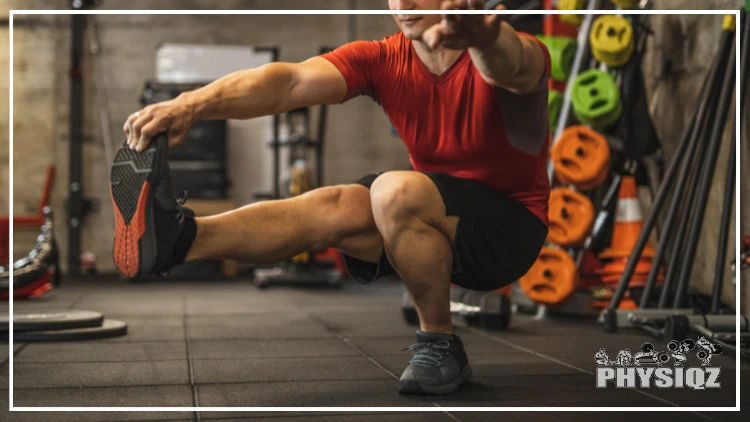
Source: DjordjeDjurdjevic via Canva.com15
Additional exercises such as deadlifts are a great way to target the same muscle groups that are involved in back squats. Along with significantly hitting the hamstrings, a deadlift workout is great for targeting core and back muscle growth too.
Lifters wanting an alternative that is easier on the knees and hits can use generalized squatting alternatives. This can include using machines instead. For example, the leg press, leg extension, and leg curl machines are great ways to hit the same squat muscles without putting additional pressure on certain joints.
There are even strengthening exercises and stretches for knee pain treatment; lifters who experience joint pain should utilize functional movement strategies to improve their discomfort.
Benefits of Back Squat Workout
There are a number of different back squat workout benefits. Of course, most weight lifters focus on the strength, muscle size, and body fat benefits of incorporating back squats into a workout regime.
However, there are many more benefits that aren’t often discussed but are important to mention. Below includes the additional benefits of back squatting, as well as the ways to achieve the numerous benefits.
Compound Movements Are Best for Muscle Growth
Compound exercises are great for building muscle and involve working multiple muscle groups at once. Compound movement exercises include many of the Olympic lifts such as deadlifts, squats, and cleans. They can also include other complex exercises such as lunges and lunge variations.
Research shows that compound movements involving multiple joints will significantly increase muscle strength when integrated into a workout program.16 In addition to muscle hypertrophy or muscle growth, compound movements can aid in the decreasing of overall body fat and improve generalized stability and balance development.
Hormonal Response
As many health enthusiasts already know, lifting weights can aid in hormone regulation and boost testosterone. When it comes to lifting, research suggests that an adequate amount of sets will increase many hormones in order to stimulate tissue regeneration as well as muscle hypertrophy.17
This positive hormone response is key for not only building muscle, but for also improving overall health.
With the vast amount of information out there, it can be intimidating for those trying to determine the best squat routines for muscle growth. By using the guidelines above, lifters can determine the best back squat workout, as well as how to use barbell routines and Crossfit workouts of the day to maximize their results.
References
1Man Performing a Crossfit Back Squat Exercise – Photos by Canva. (n.d.). Canva. Retrieved April 19, 2023, from <https://www.canva.com/photos/MAEOlTR0-hw-man-performing-a-crossfit-back-squat-exercise/>
2photology2000. Canva. Accessed 19 April 2023. <https://www.canva.com/photos/MAFGIRamHb0-sportswoman-doing-barbell-back-squat/>
3Hospital for Special Surgery. 2022. How to Perform a Squat: Tips for Proper Form and Technique. The Playbook Strategies to Keep You In the Game of Life. Web. Retrieved on 28 November 2022. <https://www.hss.edu/playbook/how-to-perform-a-squat-tips-for-proper-form-technique/>
4Fradkin, A. J., Zazryn, T. R., & Smoliga, J. M. (2010). Effects of warming-up on physical performance: a systematic review with meta-analysis. Journal of strength and conditioning research, 24(1), 140–148. <https://doi.org/10.1519/JSC.0b013e3181c643a0>
5Back Squat – Photos by Canva. (n.d.). Canva. Retrieved April 19, 2023, from <https://www.canva.com/photos/MAEIyj8AwP0-back-squat/>
6Baz-Valle, E., Balsalobre-Fernández, C., Alix-Fages, C., & Santos-Concejero, J. (2022). A Systematic Review of The Effects of Different Resistance Training Volumes on Muscle Hypertrophy. Journal of human kinetics, 81, 199–210. <https://doi.org/10.2478/hukin-2022-0017>
7Meroni, R., Cerri, C. G., Lanzarini, C., Barindelli, G., Morte, G. D., Gessaga, V., Cesana, G. C., & De Vito, G. (2010). Comparison of active stretching technique and static stretching technique on hamstring flexibility. Clinical journal of sport medicine : official journal of the Canadian Academy of Sport Medicine, 20(1), 8–14. <https://doi.org/10.1097/JSM.0b013e3181c96722>
8Antonio, J., Ellerbroek, A., Silver, T., Orris, S., Scheiner, M., Gonzalez, A., & Peacock, C. A. (2015). A high protein diet (3.4 g/kg/d) combined with a heavy resistance training program improves body composition in healthy trained men and women–a follow-up investigation. Journal of the International Society of Sports Nutrition, 12, 39. <https://doi.org/10.1186/s12970-015-0100-0>
9Schlegel P. (2020). CrossFit® Training Strategies from the Perspective of Concurrent Training: A Systematic Review. Journal of sports science & medicine, 19(4), 670–680. <https://www.ncbi.nlm.nih.gov/pmc/articles/PMC7675627/>
10Professional athlete makes squats with a bar – Photos by Canva. (n.d.). Canva. Retrieved April 19, 2023, from <https://www.canva.com/photos/MADFqOOhhfU-professional-athlete-makes-squats-with-a-bar/>
11Young Man Performing Heavy Back Squats Exercise in Gym – Photos by Canva. (n.d.). Canva. Retrieved April 19, 2023, from <https://www.canva.com/photos/MAEud9JYNKM-young-man-performing-heavy-back-squats-exercise-in-gym/>
12Plotkin, D., Coleman, M., Van Every, D., Maldonado, J., Oberlin, D., Israetel, M., Feather, J., Alto, A., Vigotsky, A. D., & Schoenfeld, B. J. (2022). Progressive overload without progressing load? The effects of load or repetition progression on muscular adaptations. PeerJ, 10, e14142. <https://doi.org/10.7717/peerj.14142>
13Myer, G. D., Kushner, A. M., Brent, J. L., Schoenfeld, B. J., Hugentobler, J., Lloyd, R. S., Vermeil, A., Chu, D. A., Harbin, J., & McGill, S. M. (2014). The back squat: A proposed assessment of functional deficits and technical factors that limit performance. Strength and conditioning journal, 36(6), 4–27. <https://doi.org/10.1519/SSC.0000000000000103>
14Schoenfeld, B. J., Grgic, J., Van Every, D. W., & Plotkin, D. L. (2021). Loading Recommendations for Muscle Strength, Hypertrophy, and Local Endurance: A Re-Examination of the Repetition Continuum. Sports (Basel, Switzerland), 9(2), 32. <https://doi.org/10.3390/sports9020032>
15Mid adult sports man doing single leg squat in gym – Photos by Canva. (n.d.). Canva. Retrieved April 19, 2023, from <https://www.canva.com/photos/MAEEKM8e9d8-mid-adult-sports-man-doing-single-leg-squat-in-gym/>
16Paoli, A., Gentil, P., Moro, T., Marcolin, G., & Bianco, A. (2017). Resistance Training with Single vs. Multi-joint Exercises at Equal Total Load Volume: Effects on Body Composition, Cardiorespiratory Fitness, and Muscle Strength. Frontiers in physiology, 8, 1105. <https://doi.org/10.3389/fphys.2017.01105>
17Wilk, M., Petr, M., Krzysztofik, M., Zajac, A., & Stastny, P. (2018). Endocrine response to high intensity barbell squats performed with constant movement tempo and variable training volume. Neuro endocrinology letters, 39(4), 342–348. <https://pubmed.ncbi.nlm.nih.gov/30531700/>